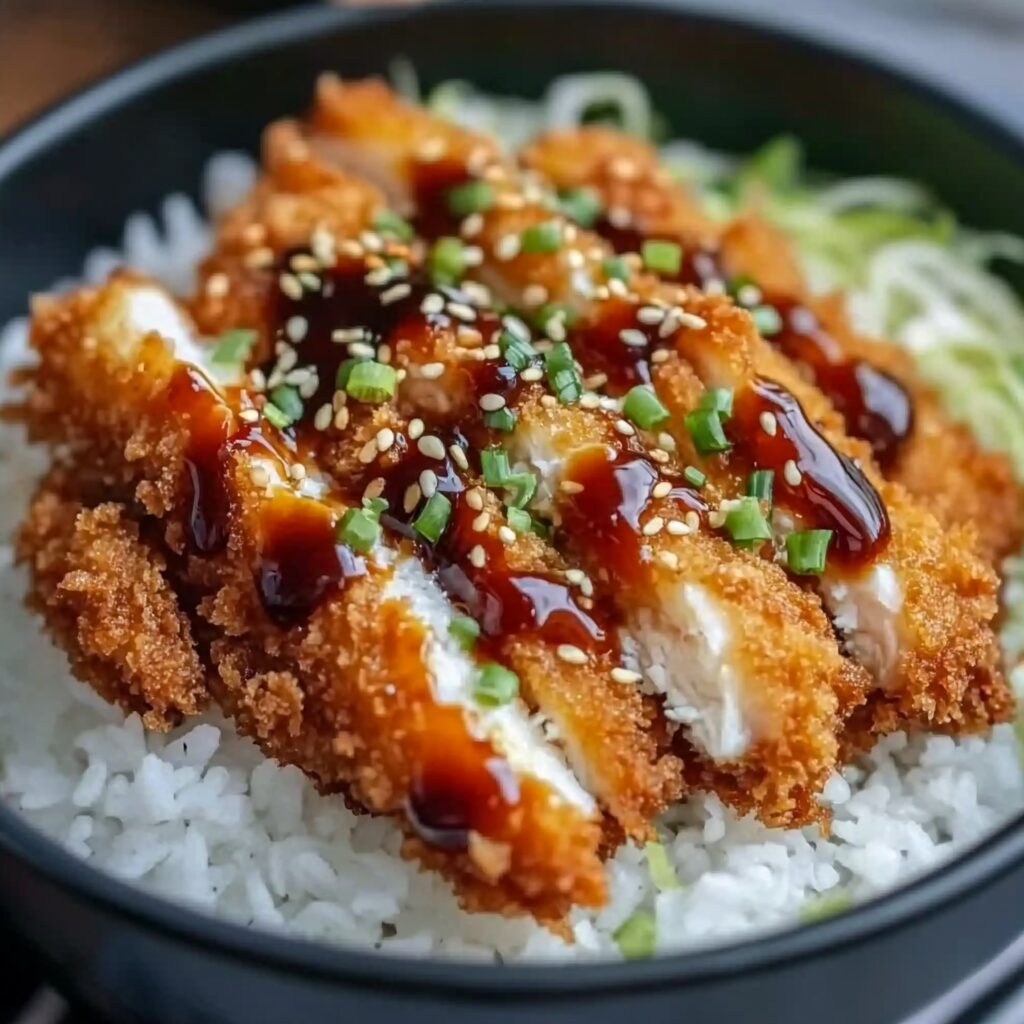Japanese Katsu Bowls with Tonkatsu Sauce offer a delightful combination of crispy, golden-brown breaded cutlets—either chicken or pork—served over fluffy white rice and drizzled with a rich, tangy tonkatsu sauce. This dish brings the bold and savory flavors of Japan to your table, making it a comforting and satisfying meal. Whether you’re a fan of Japanese cuisine or looking to try something new, this recipe is sure to impress.
Full Recipe
Ingredients:
-
For the Katsu:
-
2 boneless pork chops or chicken breasts
-
Salt and pepper, to taste
-
1/2 cup all-purpose flour
-
1 large egg, beaten
-
1 cup panko breadcrumbs
-
Vegetable oil, for frying
-
-
For the Tonkatsu Sauce:
-
1/4 cup ketchup
-
2 tablespoons Worcestershire sauce
-
1 tablespoon soy sauce
-
1 tablespoon mirin (or honey as a substitute)
-
1 teaspoon Dijon mustard
-
1/2 teaspoon garlic powder
-
-
For the Bowl:
-
2 cups cooked Japanese short-grain rice
-
1/2 cup shredded cabbage
-
1 green onion, sliced
-
Toasted sesame seeds (optional)
-
Directions:
-
Prepare the Katsu:
-
Season the pork or chicken with salt and pepper.
-
Dredge in flour, then dip into the beaten egg, and coat with panko breadcrumbs.
-
Heat about 1/2 inch of vegetable oil in a pan over medium heat.
-
Fry each cutlet for about 3-4 minutes per side until golden brown and cooked through.
-
Transfer to a wire rack or paper towel to drain excess oil.
-
-
Make the Tonkatsu Sauce:
-
In a small bowl, whisk together ketchup, Worcestershire sauce, soy sauce, mirin, mustard, and garlic powder until smooth.
-
-
Assemble the Katsu Bowl:
-
Place a generous scoop of rice in a bowl.
-
Slice the crispy katsu into strips and arrange on top of the rice.
-
Drizzle with homemade tonkatsu sauce.
-
Garnish with shredded cabbage, green onions, and sesame seeds.
-
Prep Time: 15 minutes
Cooking Time: 15 minutes
Total Time: 30 minutes
Kcal: 550 kcal
Servings: 2 servings
Introduction to Japanese Katsu Bowls
Japanese Katsu Bowls with Tonkatsu Sauce are a beloved comfort food in Japan and around the world, combining the crunch of deep-fried cutlets with the warm satisfaction of a rice bowl. Known for their simplicity and powerful flavor profile, Katsu Bowls typically feature either pork (tonkatsu) or chicken (chicken katsu) as the star protein, which is breaded with airy panko breadcrumbs and fried until perfectly golden. Served on a bed of steamed Japanese rice and topped with shredded cabbage and a sweet-savory sauce, this dish captures the essence of homestyle Japanese cooking with restaurant-quality flavor.
Katsu bowls are as versatile as they are delicious. With minimal ingredients and straightforward preparation, they’re an excellent meal option for weeknights, lazy weekends, or when you’re craving a satisfying yet easy-to-make dinner. The combination of textures—from the crispy cutlet to the soft, sticky rice, and the fresh crunch of cabbage—makes every bite interesting and delightful.
A Brief History of Tonkatsu and Katsu Dishes
The origins of tonkatsu (pork cutlet) date back to the late 19th century during the Meiji era, a period when Japan began to embrace more Western influences in its cuisine. Tonkatsu was inspired by European-style breaded and fried meat cutlets, like the French côtelette or Austrian schnitzel. However, the Japanese adapted it to local tastes by using panko breadcrumbs and pairing it with rice and shredded cabbage instead of mashed potatoes or heavy cream sauces.
As Japanese cuisine continued to evolve, so did katsu dishes. Chicken katsu became popular as a leaner alternative, and variations including katsu sandwiches (katsu sando), curry katsu (served with Japanese curry), and the rice bowl variant—katsudon—emerged. Today, Katsu Bowls represent a modern, accessible version that’s popular not just in Japan but in homes and restaurants around the globe.
What Sets a Katsu Bowl Apart
The beauty of a Katsu Bowl lies in its simplicity. At its core, it’s a dish made from everyday pantry ingredients—but it tastes anything but ordinary. Panko breadcrumbs, unique to Japanese cooking, are lighter and crispier than traditional breadcrumbs, creating an incredibly crunchy coating that stays crispy even after frying. The short-grain Japanese rice, with its chewy texture and slightly sticky quality, is the ideal base to soak up the tonkatsu sauce.
Speaking of sauce, the tonkatsu sauce is truly the heart of the dish. It’s thick, tangy, a little sweet, and rich with umami. Often compared to a Japanese-style barbecue sauce, it’s made from a blend of ketchup, soy sauce, Worcestershire sauce, and other flavorings like garlic, mustard, and sugar. While store-bought versions exist, making it at home is simple and allows you to tailor the flavor exactly to your liking.
Cultural Significance and Comfort Food Appeal
In Japan, katsu dishes are considered comfort food—akin to how people in the West feel about fried chicken or mac and cheese. They’re especially popular among students and working adults who want a hearty, home-cooked meal without too much fuss. Eating a katsu bowl can feel like wrapping yourself in a warm blanket—it’s deeply satisfying, nourishing, and mood-lifting.
There’s also a cultural superstition tied to katsu. In Japanese, “katsu” also means “to win” or “victory,” which is why students often eat tonkatsu or katsu curry before exams or important events for good luck. It’s not just a meal—it’s a symbol of triumph and encouragement.
Health and Dietary Considerations
Although Katsu Bowls are fried, they can still be a balanced meal when portioned correctly and paired with vegetables. The lean protein provides essential nutrients, while the rice offers energy-giving carbohydrates. Shredded cabbage adds fiber, and you can easily incorporate other vegetables such as steamed broccoli, edamame, or pickled daikon for extra color and nutrition.
For those seeking lighter options, air-frying the cutlet or using the oven instead of deep-frying is a practical alternative. Gluten-free panko and tamari can replace regular breadcrumbs and soy sauce, respectively, to make the dish gluten-free. It’s also adaptable to vegetarian versions using tofu or eggplant in place of meat.
Modern Variations and Toppings
Modern food culture has brought many exciting twists to traditional Japanese Katsu Bowls. Some people like to add a soft-boiled egg or onsen tamago on top for added richness. Others use spicy mayo or even drizzle a bit of wasabi-infused dressing to elevate the flavor. Popular side garnishes include pickled ginger, nori strips, sesame seeds, or scallions.
You can also experiment with the base of the bowl. While white rice is the classic choice, brown rice, quinoa, or even cauliflower rice can make excellent substitutes depending on dietary preferences. Some fusion versions even feature kimchi or sriracha for a Korean or spicy twist.
Why You Should Try Making Katsu Bowls at Home
While it might seem easier to order a katsu bowl from your favorite Japanese restaurant or takeout spot, making it at home is far more rewarding—and often healthier. You have complete control over the ingredients, oil quality, and seasoning. Plus, it’s an excellent way to introduce friends or family to Japanese cuisine in a very approachable way.
Another benefit is the ability to scale the recipe easily. You can double the portions for meal prepping or serve it family-style on a weekend dinner. The components—rice, cutlets, cabbage, and sauce—can all be made in advance and assembled just before serving.
Tips for Perfect Katsu Every Time
Achieving the ideal crispy texture without overcooking the meat requires a few simple techniques:
-
Use panko, not regular breadcrumbs. Panko is essential for the light, flaky coating that defines katsu.
-
Don’t skip the flour and egg steps. These layers help the panko adhere and create a better crust.
-
Use medium-high heat oil. Don’t overcrowd the pan, and keep the oil temperature steady to avoid soggy results.
-
Let it rest. After frying, let the katsu rest on a wire rack. This keeps it crisp and allows juices to redistribute.
Conclusion: A Classic Dish Worth Mastering
Japanese Katsu Bowls with Tonkatsu Sauce are more than just a quick dinner idea—they’re a culinary experience that blends crispy texture, balanced flavors, and satisfying comfort. With roots in Japanese history and a modern appeal that resonates across the globe, this dish proves that simplicity doesn’t mean boring. Whether you’re cooking for yourself or sharing with others, a well-made katsu bowl brings joy, warmth, and a little piece of Japan to your kitchen.
Mastering this dish opens the door to endless possibilities in Japanese home cooking. It’s a stepping stone to exploring other beloved dishes like katsudon, curry katsu, or even homemade bento boxes. Once you’ve tasted your own crispy katsu drizzled in tangy, homemade sauce, there’s no going back.





